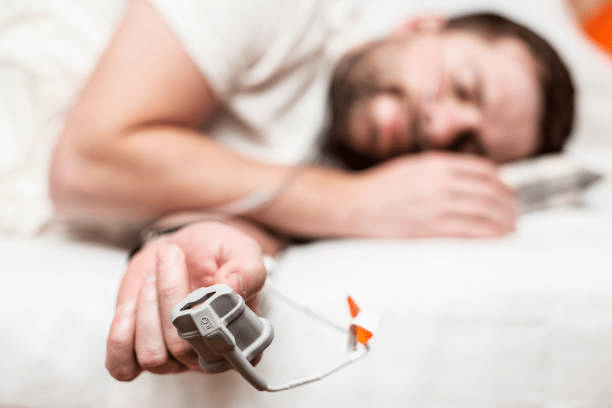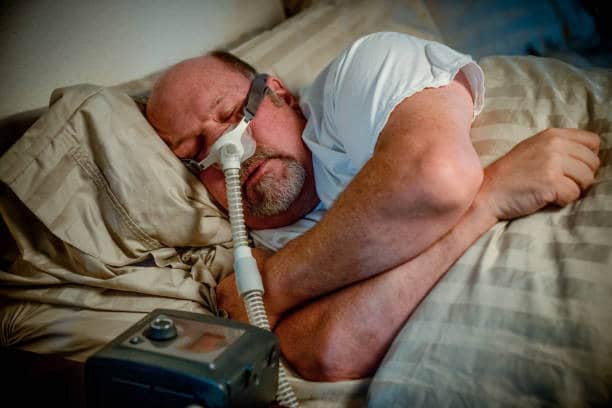During an average hour of sleep, the apnea-hypopnea index (AHI) measures the frequency of breathing disruptions, such as delays or reductions. This essential metric is obtained through sleep studies, which are exhaustive overnight tests conducted in hospitals, sleep clinics, or at home.
The AHI is particularly useful for identifying and evaluating the severity of obstructive sleep apnea (OSA). Sleep studies are essential for diagnosing various sleep disorders. OSA occurs when the airway repeatedly narrows or closes during sleep, causing difficulty breathing.
In this article, we at CPAPwater will delve into the intricacies of AHI, explaining its definition and significance in diagnosing and managing sleep apnea. By the end of this article, you will have a comprehensive understanding of AHI and its role in assessing and addressing sleep disorders.
What Is Apnea Hypopnea Index (AHI)?
The Apnea Hypopnea Index (AHI) is a numerical measurement used to quantify the severity of obstructive sleep apnea syndrome. It represents the average number of sleep apnea and hypopnea events per hour. An event refers to a complete cessation of airflow (apnea) or a significant reduction in airflow (hypopnea) lasting for a specified duration, typically 10 seconds or more. AHI objectively assesses the frequency and intensity of breathing disruptions during sleep.
Calculation And Measurement Of Ahi

To calculate the AHI, sleep studies are conducted in specialized sleep laboratories or through home sleep testing devices. These studies are conducted under the supervision of sleep specialist. Various parameters related to sleep and breathing are monitored during these studies, including airflow, oxygen levels, respiratory effort, and body movements.
These data are recorded and analyzed by sleep medicine professionals to identify and quantify apnea and hypopnea events.
The AHI is calculated by dividing the total number of apnea and hypopnea events by the total number of hours of sleep recorded. The formula for AHI is as follows:
AHI = (Number of Apneas + Number of Hypopneas) / Total Sleep Time (in hours)
For example, if a person experiences 30 apneas and 40 hypopneas during 8 hours of sleep, the AHI would be:
AHI = (30 + 40) / 8 = 12.5
Ahi Interpretation And Severity Levels
The AHI is used to classify the severity of sleep apnea into different categories. The severity levels are as follows:
- Normal: AHI less than 5
- Mild Sleep Apnea: AHI between 5 and 15
- Moderate Sleep Apnea: AHI between 15 and 30
- Severe Sleep Apnea: AHI more significant than 30
It’s important to note that AHI alone does not provide a comprehensive picture of the individual’s symptoms and overall health impact. Other factors, such as symptoms like excessive daytime sleepiness or comorbidities, are also considered in the diagnosis and treatment of sleep apnea.
How AHI Is Determined
To determine the Apnea Hypopnea Index, a sleep study, known as polysomnography, is conducted. Polysomnography is a comprehensive sleep assessment that monitors various physiological parameters during sleep. It is typically performed in a sleep laboratory, but technological advancements have also made home sleep testing devices available in some instances.
During a sleep study, several sensors monitor and record different aspects of sleep. These sensors include:
- Nasal Cannula: It measures the airflow through the nose and detects any interruptions or reductions in breathing.
- Chest and Abdominal Belts: These belts measure respiratory effort by monitoring the expansion and contraction of the chest and abdomen during breathing.
- Pulse Oximeter: It measures oxygen saturation levels in the blood, providing information about oxygen levels during apnea and hypopnea events.
- Electroencephalogram (EEG) records brainwave patterns and helps identify different sleep stages.
- Electrooculogram (EOG) monitors eye movements, determining rapid eye movement (REM) sleep.
- Electromyogram (EMG): It measures muscle activity, including chin and leg movements, which can be indicators of sleep disturbances.
Throughout the sleep study, the various sensors record data related to breathing patterns, including apneas, hypopneas, and regular breathing events. Apneas are characterized by a complete cessation of airflow, while hypopneas involve a partial reduction in airflow. These events are identified based on predefined criteria, such as the interruption duration and the percentage of airflow reduction.
Sleep technologists analyze the recorded data and manually score each apnea and hypopnea event. They differentiate between obstructive sleep apnea (OSA), where airflow is blocked despite respiratory effort, and central sleep apnea (CSA), where respiratory effort is lacking. The AHI can be calculated using the formula mentioned earlier by accurately scoring these events.
Also Read: What You Should Know About AHI, Rera Arousal, and RDI
Importance Of AHI In Sleep Disorders

The Apnea Hypopnea Index (AHI) is a crucial diagnostic tool for sleep apnea. A sleep study is conducted to confirm the diagnosis when an individual presents with symptoms suggestive of sleep apnea, such as loud snoring, daytime sleepiness, or morning headaches. The AHI value obtained from the sleep study helps determine whether sleep apnea is present and objectively measures its severity.
The AHI is an essential metric in assessing the severity of sleep apnea. By quantifying the average number of apnea and hypopnea events per hour of sleep, the AHI categorizes the severity into different levels: normal, mild, moderate, and severe. This classification enables healthcare professionals to gauge the impact of sleep apnea on an individual’s health and well-being.
Treatment Decisions Based On AHI Values
AHI values heavily influence treatment decisions for individuals with sleep apnea. Different treatment options may be recommended based on the severity of the condition. Here’s how AHI values guide treatment decisions:
1. Mild Sleep Apnea
For individuals with mild sleep apnea (AHI between 5 and 15), lifestyle modifications and positional therapy may be suggested as the initial approach. These interventions include weight loss, avoiding sleeping on the back, and improving sleep hygiene practices.
2. Moderate Sleep Apnea
In cases of mild sleep apnea (AHI between 15 and 30), continuous positive airway pressure (CPAP) therapy is commonly recommended. During sleep, CPAP involves wearing a mask over the nose or nose and mouth, delivering a constant stream of air to keep the airway open.
3. Severe Sleep Apnea
CPAP therapy is typically the primary treatment option for individuals with severe sleep apnea (AHI more significant than 30). Other interventions like oral appliances or surgery may sometimes be considered.
The AHI also helps assess the effectiveness of treatment over time. Follow-up sleep studies may be conducted to monitor changes in AHI values and determine if adjustments to the treatment plan are necessary.
Comprehending The Apnea-Hypopnea Index Across Different Age Groups

The Apnea Hypopnea Index (AHI) varies across different age groups, and its interpretation requires consideration for specific populations. In adults, the standard criteria for AHI interpretation, as mentioned earlier, are commonly applied. These criteria help classify the severity of sleep apnea and guide treatment decisions accordingly.
The AHI provides valuable information about the impact of sleep apnea on adults’ health and assists in developing personalized treatment plans.
In children, evaluating sleep-disordered breathing, including the calculation of AHI, requires additional considerations due to physiological and developmental differences. Children may have naturally smaller airways and undergo various stages of growth and development that can influence breathing patterns during sleep.
Due to sleep apnea’s unique characteristics in youngsters, AHI results are interpreted differently. Age-specific norms or percentiles are used to evaluate children’s AHI results. Pediatric sleep experts utilize specific guidelines to interpret AHI values in children and classify the severity of sleep apnea accordingly.
Additionally, the symptoms and consequences of sleep apnea in children can differ from those in adults. Children may exhibit behavioral problems, difficulty concentrating, and poor academic performance, among other issues. Thus, healthcare professionals consider the overall clinical picture, including symptoms and potential comorbidities, in conjunction with the AHI values to effectively diagnose sleep apnea in pediatric patients.
Other Parameters Related to AHI
In addition to the Apnea Hypopnea Index (AHI), another parameter called the Respiratory Disturbance Index (RDI) is often considered in sleep studies. The RDI encompasses a broader range of respiratory events, including apneas and hypopneas, and other respiratory disturbances, such as respiratory effort-related arousals (RERAs).
RERAs are characterized by a partial arousal from sleep due to increased respiratory effort without meeting the criteria for hypopneas or apneas.
The RDI provides a comprehensive measure of the overall respiratory disturbances during sleep. It includes events that may not meet the strict criteria for apneas or hypopneas but still contribute to sleep fragmentation and oxygen desaturation. The RDI can provide additional information to complement the AHI in assessing the impact of sleep-disordered breathing on an individual’s sleep quality and overall health.
The Oxygen Desaturation Index (ODI) is another parameter closely related to the AHI. It counts large blood oxygen reductions from apneas, hypopneas, and other breathing episodes during sleep. When the airway is partially or totally obstructed, oxygen saturation lowers.
Divide the number of major oxygen desaturations by the number of hours of sleep to get the ODI. It shows the degree of oxygen desaturation events during sleep and helps explain how sleep-disordered breathing affects oxygenation levels.
The Impact Of OSA Treatment On The AHI

Treating sleep apnea is of paramount importance for overall health and well-being. OSA can have profound consequences, including an increased risk of cardiovascular disease, hypertension, diabetes, and diurnal sleepiness, if left untreated. Effective treatment alleviates symptoms and reduces the associated health risks, improving the individual’s quality of life.
The Role of AHI Monitoring In Evaluating Treatment Effectiveness
AHI monitoring plays a vital role in evaluating the effectiveness of sleep apnea treatment. After initiating treatment, whether through continuous positive airway pressure (CPAP) therapy, oral appliances, surgery, or other interventions, regular follow-up sleep studies are conducted to assess changes in the AHI. These follow-up studies help determine if the treatment adequately controls apnea and hypopnea events during sleep.
A significant reduction in the AHI indicates a positive response to treatment. It signifies that the therapy effectively maintains an open airway and prevents respiratory disturbances during sleep. Monitoring the AHI allows healthcare professionals to adjust the treatment plan if needed, to optimize its effectiveness and ensure that the individual receives the maximum benefits.
It is crucial to encourage individuals with sleep apnea to seek appropriate treatment. The reduction in AHI achieved through treatment improves sleep quality and leads to various health benefits. Sleep apnea management can boost energy, cognition, comorbidity risk, and quality of life. To support your journey towards better sleep and effective sleep apnea management, visit our Amazon shop for a comprehensive range of CPAP accessories that can help enhance your treatment experience.




